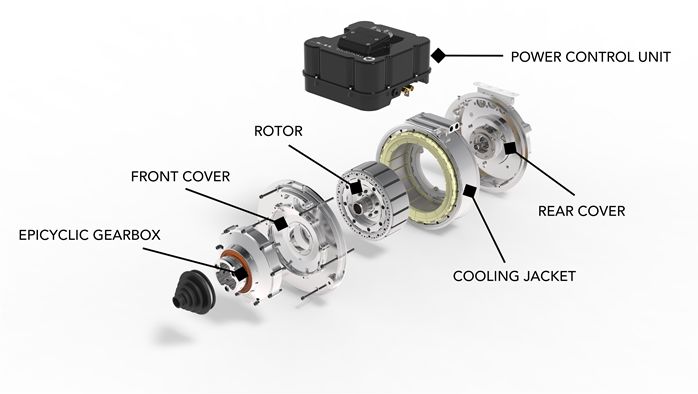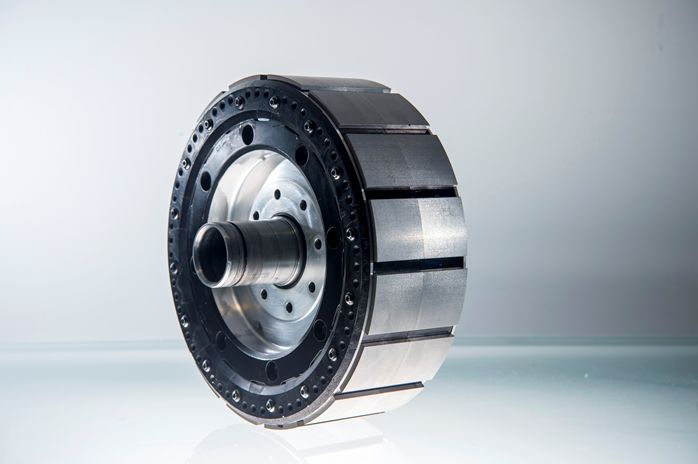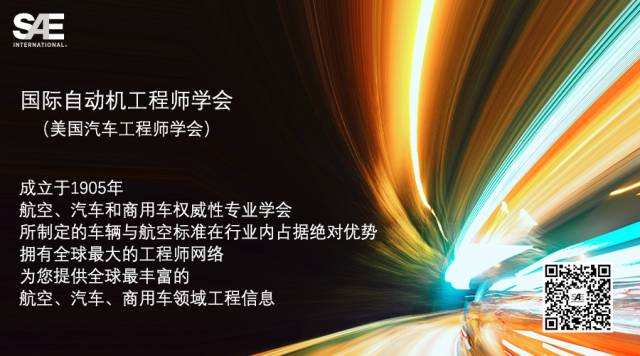 电力牵引电机的拓扑 (Equipmake)
电力牵引电机的拓扑 (Equipmake) 轮辐电机系统剖析图(Equipmake)
轮辐电机系统剖析图(Equipmake) Equipmake APM 200型轮辐电机,最大功率达220kW(295 hp),最高转速10,000rpm (Equipmake)
Equipmake APM 200型轮辐电机,最大功率达220kW(295 hp),最高转速10,000rpm (Equipmake)
在电动汽车的新大陆上,有一场争论的硝烟从未散去——到底哪种电机是最好的?
对此,Equipmake的经营主管、创新型电力传动系统设计研发专家Ian Foley表示,“这就像80年代早期的计算机之争。直到IBM的PC成为业界标准,这场争论才得以平息。现在我们有各种类型的电机,不同的电机的制造理念也不一样。我们不应只着眼于电机,而是要考察包括电机、电池、逆变器、齿轮箱和控制器在内的整体系统解决方案。最后,哪个解决方案成本最低,哪个就是赢家。”
Foley希望,最后的胜利属于自己公司的APM200轮辐电机。他表示,APM200效率卓越,是目前扭矩和功率密度(kW/kg)最高的电动汽车永磁电机,而且它还有成本低、重量轻等优点。
APM200电机的重量约为49kg (108 lb),最高转速为10,000rpm,最大功率和最大扭矩分别为220kW(295 hp) and 450 N·m (332 lb·ft),采用了成本更低的钕铁硼磁铁(NdFeB),降低了电机整体造价,并搭载了5.5:1整体行星齿轮箱,齿轮箱的输出轴和轮毂直接相连。此外,Equipmake还为APM200研发了专用逆变器,采用了结合碳化硅二极管和IGBT(绝缘栅双极晶体管)的动力电子技术,使得电机能在高变频下保持大功率运转。
一冷再冷
冷却是决定电机性能的关键。电机磁铁的温度越低,电机输出峰值功率的时间就越长。但是,光做到冷却还不够,必须要保证冷却的成本适中、质量可靠、量产效率高。
Foley表示,“轮辐电机的结构能够满足以上这些要求。传统的永磁电机的磁铁呈V型,被压在转子四周的压片上,压入深度很浅,而轮辐电机的磁铁则像辐条一样垂直于铝制转子的表面,使得磁铁得以非常接近冷却液(60℃水/乙二醇)。换言之,传统电机的磁铁是分布在压片上,所以无法接近冷却液;而轮辐电机磁铁的一端是在铝制中心毂上,所以我们可以让冷却液足够靠近磁铁,达到散热的目的。尽管和传统电机相比,轮辐电机的生产难度更高,但是我们设计的电机已经可以量产,对此我们很有信心。”
Foley表示,实现电机量产的关键在于落实设计细节,比如找到将压片安装在中心毂上的方法,“中心毂基本上是锻造件。我们的冷却非常高效,所以能获得所需的高强度。铝制中心毂的温度控制在100℃以下,因此我们可以使用成本低但性能、可靠性、寿命都毫不逊色的磁铁。热能工程是让一款电动汽车电机脱颖而出的一大关键。”
据Foley介绍,虽然轮辐结构在汽车行业的知名度还不高,但事实上其拓扑结构早已广为人知。Equipmake轮辐电机的结构还要追溯到公司此前参加的一个名为“HIPERCAR”(高性能减碳)的英国研究项目,一同参与的还有Delta Motorsport公司和Ariel公司,项目的目标是在2020年前推出量产超高性能减排跑车。正是这个项目催生了被Foley称为“目前扭矩密度最高”的Equipmake轮辐电机,Foley还表示,“该款电机的性能已经得到了充分验证,未来还会继续改进。”
APM200轮辐电机的研发耗时大约三年,Foley说,“我们成功解决了设计、冷却和制造的挑战。除了HIPERCAR项目之外,我们和一家阿根廷公司合作开展的客车应用项目也采用了APM200。我们在每辆客车上搭载了两台APM200电机、赛米控的SKA1逆变器和AESC电池。我们的目标是电机的年产量在2020年前能达到2,000台,然后再节节攀升。”
Equipmake的轮辐电机采用了铝制中心毂和钢铁压片,铝具有抗疲劳、经久耐用的性能优点,满足了产品使用寿命的要求。
至于电机定子,据介绍,APM200采用了“非常传统”的定子。目前,相关方正在对APM200进行验证,其中包括了使用寿命测试。
三句不离成本
Foley很清楚成本对汽车技术创新的重要性,“汽车行业说来说去还是成本的问题。往往工程师提出一些非常好的想法,但无奈执行成本太高,这我太了解了。所以我们想要设计出能最充分地利用磁铁的电机架构。我们用某家大型整车厂设计的EV传统电机就辐条技术进行了比较,结果发现,我们可以在减少25%磁铁数目(即降低25%成本)的情况下,输出相同的扭矩。”
Foley表示,如果能有效保持电机的冷却,就能降低成本,所以APM200轮辐电机采用了“烹饪级”磁铁,“我们的电机工作温度只有100℃左右,所以没有必要使用最高工作温度为200℃的稀土铷磁铁。”
至于Equipmake轮辐电机具体可以增加多少续航里程,Foley目前还没有透露任何参数。
奔驰的飞轮
多年来,Foley在工程和技术创新领域已经积累了非常丰富的经验。他的职业生涯开始于80年代,最早是在F1车队任职,期间研发了莲花F1主动悬挂系统,并加入了莲花GT耐力赛团队。90年代后期,他创立了Equipmake,公司早期生产过拨片式齿轮箱,许多勒芒赛的赛车都采用了该款齿轮箱。
2000年后,Foley开始研究一种新型高速电驱飞轮,后来这款飞轮被威廉姆斯车队的KERS(动能回收系统)采用。除了F1以外,这项技术在很多其它领域也得到了应用,并由此催生了一家新公司——WilliamsHybrid Power (威廉姆斯混合动力),Foley担任了该公司的经营主管。
Williams Hybrid Power公司主要是研发客车、火车等商用车的电动传动系统。后来,这家公司被GKN(吉凯恩)收购。
There is a subdued hum in the emerging world of the EV: the sound of several types of electric motor vying for top podium position within the industry.
“It is similar to the computer debate in the early 1980s before the IBM PC became the industry standard,” said Ian Foley, Managing Director of Equipmake, a specialist in the design and development of innovative electric powertrains. “Now, we have many different electric motor types, and they come with different manufacturing philosophies. It is essential to look at the whole system—motor, battery, inverter, gearbox and controls—not just motors in isolation. The lowest cost solution for all of this will win!”
And that, he hopes, will be his company’s spoke motor, designated APM200. He claims that it has already demonstrated such a high level of efficiency that it is the most torque and power dense (kW per kg) of any other types of permanent magnet motors for EVs. It also saves cost and weight, adds Foley.
The motor weighs about 49 kg (108 lb), can run at 10,000rpm, and has peak power and torque respectively of 220 kW (295 hp) and 450 N·m (332 lb·ft). Cost saving is helped by using cheaper grade neodymium iron boron (NdFeB) magnets. The motor incorporates an integral 5.5:1 epicyclic gearbox so the output shaft of the gearbox can be connected directly to the wheel hub. Equipmake also has developed an inverter specific to the APM200. It incorporates Power Electronic technology with silicon carbide diodes combined with IGBTs (Insulated Gate Bipolar Transistors) to improve power capability and allow it to run at high switching frequencies.
Keep cool, keep cool
Cooling is key to electric motor performance; the cooler its magnets, the longer it can run at maximum power. But a must is to do that at the right price and fulfil required reliability and efficient manufacturing criteria.
“Those criteria can be achieved by the spoke configuration,” explains Foley. “A conventional interior permanent magnet motor has its magnets arranged in a very shallow V shape in laminations round the circumference of the rotor; the spoke has them arranged perpendicularly like the spokes of a wheel on the surface of the aluminum rotor, enabling us to get coolants (water/glycol at 60deg C) very close to the magnets. That is not possible in a conventional configuration, which has the magnets sitting in the lamination. Because one end of the magnet is positioned in an aluminum hub, we can get a coolant path very close to it and so conduct out heat. A spoke motor is not as straightforward to manufacture as a regular design but we are confident that we have come up with a usable production version.”
Foley said the key to achieving a solution to meet volume production lay in the spoke motor’s detail design, including the way laminations fit into the hub: “Basically it is a forging that is machined during production. The fact that we can cool it so effectively means we can get the great strength needed. By keeping the aluminum below 100o C, we can use cheaper magnets, with no loss of performance, reliability or longevity. Thermal engineering is one big differentiator between types of EV motors.”
Spoke is a known topology, albeit not in the auto industry, explains Foley. But Equipmake’s involvement with the UK extreme-performance HIPERCAR (High Performance Carbon Reduction) project scheduled for production by Ariel in 2020 (in partnership with Delta Motorsport) generated research that led to the development of the spoke configuration and what Foley describes as “the most torque dense motor, which has been proven fundamentally and is leading to further development."
Its evolution has taken around three years, he said: “Design, cooling and manufacturing challenges had to be overcome. We have done that, not only for HIPERCAR but also for a bus application, working with an Argentian partner using two APM200 motors. The bus project mates the motors with Semikron SKA1 inverters and AESC batteries. We expect to produce about 2000 motors a year by 2020 and ramp up from there.”
Equipmake’s spoke motor benefits from using aluminum for the hub with steel laminations because the material’s properties, notably fatigue and life, are known and able to provide the design life requirements.
The APM 200’s stator is described as “completely conventional." A validation program which includes life testing is now under way.
All about cost
Foley is very well aware of the financial aspect of fresh to automotive technologies: “Everything in the auto industry is about cost; I know very well that engineers are very good at dreaming up great ideas that sometimes cost too much! But having the architecture that gets the most out of the magnets is what matters. We carried out an analytical comparison of spoke technology with a major OEM’s EV conventional rotor and found we could get the same torque with 25% fewer (and cheaper) magnets.”
The spoke motor incorporates what Foley calls “cooking grade” magnets because keeping the temperature of the motor down also brings down costs: “It is not necessary to use rare earth neodymium magnets that work at up to 200o C; we are operating at half that.”
He has not released any specific figures for the Equipmake spoke motor with regard to its contribution to increased vehicle range.
Learning from flywheels, racing
Foley is a highly-experienced engineer and technology innovator. He spent the early part of his career (1980s and 90s) with a variety of F1 teams, working with Lotus F1 on active suspension for several years and was involved with Lotus’ GT endurance team. He formed Equipmake in the late 1990s and one of its first projects was the production of a paddleshift gearbox used at Le Mans by many competing cars.
In the 2000s he began work on a new type of high-speed electric flywheel, which found success in 2009 with Williams F1 in its Kinetic Energy Recovery System (KERS). The technology had many applications beyond F1. As a result, a new company was formed, Williams Hybrid Power, of which Foley was managing director.
Williams Hybrid Power developed electric powertrains for commercial vehicles including buses and trains and subsequently was bought by GKN.
等级
打分
- 2分
- 4分
- 6分
- 8分
- 10分
平均分
- 作者:Stuart Birch
- 行业:汽车
- 主题:制造质量、可靠性与耐久性电气电子与航空电子
